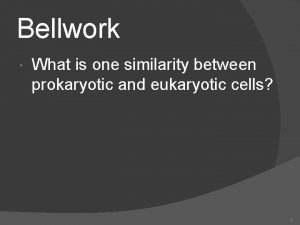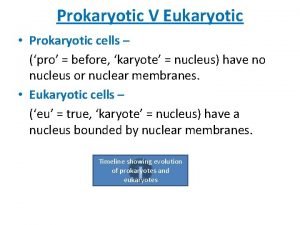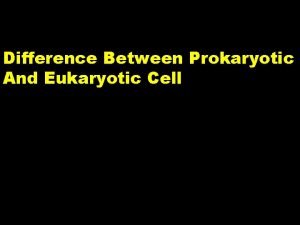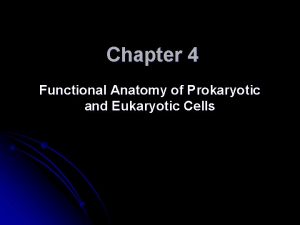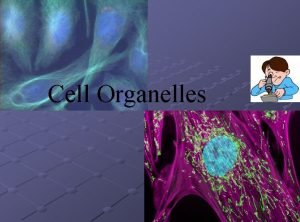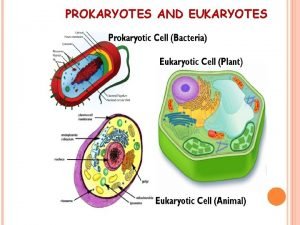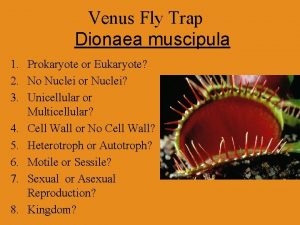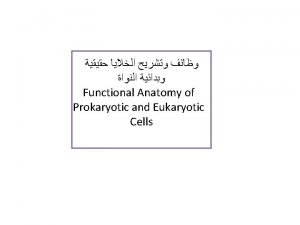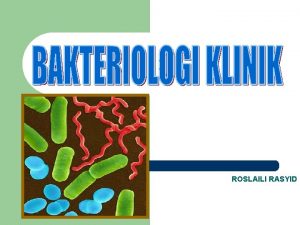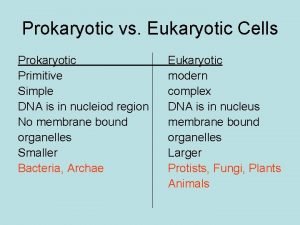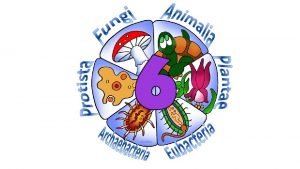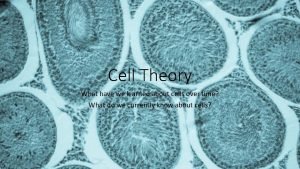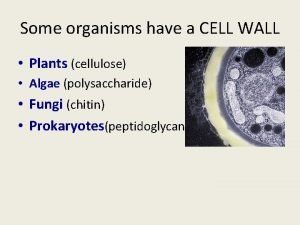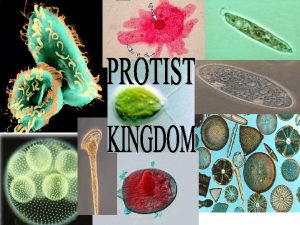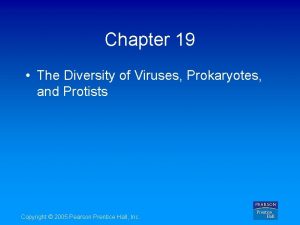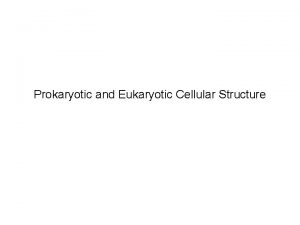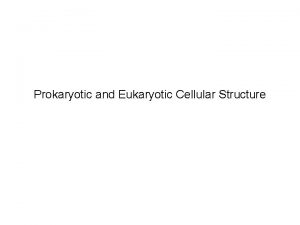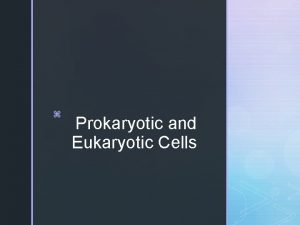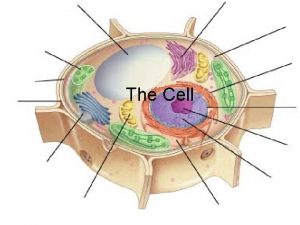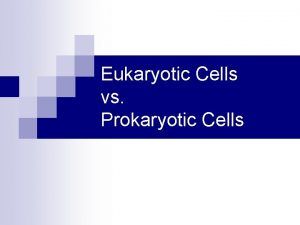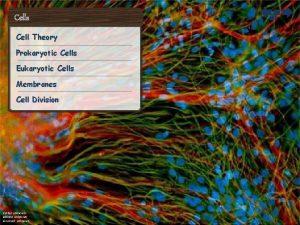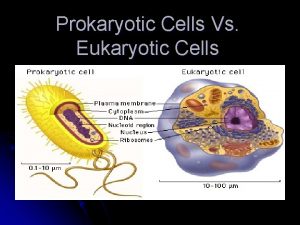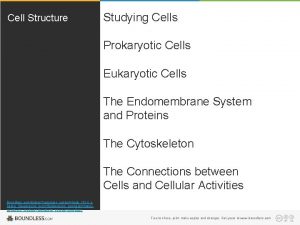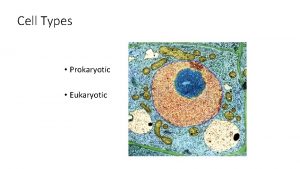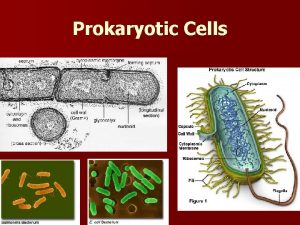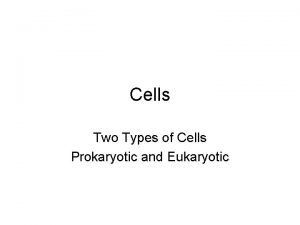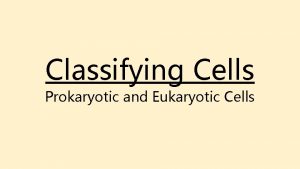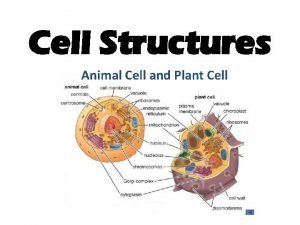2 2 2 3 PROKARYOTIC AND EUKARYOTIC CELLS

































- Slides: 33

2. 2 &2. 3 PROKARYOTIC AND EUKARYOTIC CELLS SBI 3 UC http: //www. studiodaily. com/2006/07/cellular -visions-the-inner-life-of-a-cell/

PROKARYOTIC CELLS • They are single-celled organisms, and they lack membrane-bound organelles. (no organized nucleus, vacuoles etc. ) • Examples include bacteria, archaea and bluegreen algae

CELL STRUCTURE

STRUCTURES • 1. Cell surface membrane (plasma membrane): controls which materials enter and leave the cell, either by active or passive. It is selectively permeable. • 2. Cell wall: Rigid or semi-rigid wall surrounding plasma membrane. Contains pores to allow passage of materials in & out. The cell wall supports cell and provides shape.

STRUCTURES • Plasmid: Small circular pieces of naked DNA in addition to main chromosome of prokaryote cells. • Nucleoid: Region of prokaryote cytoplasm where main chromosome and plasmid are found. Naked DNA - DNA is not bound to proteins (like histones) to reduce the amount of

MESOSOME • Mesosome: Internal membrane connected to the cell surface membrane. It increases the area available to make ATP (cell energy). It may also aid the replication of DNA and cell division.

PILI • Pili- are thin protein tube, found outside of the plasma membrane. • Attachment pili (fimbriae) – allow prokaryotes to stick to surfaces • Conjugation pili (sex pili) – few in number, but longer than attachment pili. They build a bridge between cells and allow an exchange of plasmids.

STRUCTURES • Cytoplasm: Contains enzymes for catalyzing chemical reactions of metabolism. Contains ribosomes and naked DNA. • Ribosome: Sites of protein synthesis (scattered throughout cytoplasm rather than in rough ER). • Flagellum: One to many threadlike, motile structures (locomotion). • Slime capsule: Layer of thick, jellylike polysaccharides surrounding some prokaryote cells to aid in protection.

DIVISION • Prokaryotic cells divide by BINARY FISSION • They double their chromosome number and then split in half

PROKARYOTIC CELLS The photo above shows a cross-section through a prokaryotic cell. Can you identify any of the parts?

METABOLIC ACTIVITY (NICHES) OF PROKARYOTIC CELLS • 1. Photosynthesis- Blue-green algae convert light energy into chemical energy (food) • 2. Nitrogen Fixation- Nitrogen-fixing bacteria convert gaseous nitrogen from air into nitrogen compounds. (rhizobium) • 3. Fermentation- Some bacteria convert sugars to lactic acid or into alcohol in order to obtain energy. The latter 2 chemicals are then released.

EUKARYOTIC CELLS • Symbiosis: two organisms live closely together • Endosymbiosis: one organism lives inside another (like bacteria live inside of us) • https: //www. youtube. com/watch? v=-FQm. Anm. LZt. E • https: //www. youtube. com/watch? v=b. Bj. D 4 A 7 R 2 x. U

THEORY OF ENDOSYMBIOSIS • It is thought that chloroplasts and mitochondria were originally free-living prokaryotic cells which gradually became able to live and reproduce within a larger cell. • The larger cell provided protection and in some cases food to the prokaryote, while the smaller prokaryotic cell (which became the chloroplasts & mitochondria) provided an energy supply to the larger cell.

EVIDENCE • a. mitochondria and chloroplasts surrounded by double membrane • b. mitochondria and bacteria have similar size • c. mitochondrial ribosomes resemble bacterial ribosomes • d. mitochondria and chloroplast DNA is circular like bacteria • e. mitochondria divides by simple fission like bacteria

ORGANELLE'S • Organelles: Any discrete structure within a cell which has a specific function. Organelles • a) are each surrounded by a plasma membrane. • b) separate and compartmentalize chemical reactions in time and space (They organize reactions so they can be more efficient. ). • c) are only found in all eukaryotic cells (They do not exist in prokaryotes. ). • Intracellular: found inside the cell (within cytoplasm). • Extracellular: found on outer surface of cell.

INTRACELLULAR ORGANELLES • 1) Plasma membrane: Outer surface of animal cells. Phospholipid bilayer. Controls entry & exit of molecules. • Phospholipid bilayer (polar head=hydrophilic; non-polar tails =hydrophobic)

NUCLEUS • 2) Nucleus: information center of cell. • Largest organelle, readily visible. Nuclear envelope: double membrane layer, restricts passage of molecules. Chromosomes: contain heredity information (made of DNA & proteins). • Nucleolus: in center of nucleusmanufactures ribosomes.

ENDOPLASMIC RETICULUM • 3) Endoplasmic reticulum: Tubules for transport and synthesis of large organic molecules. Often continuous with nuclear envelop. Organizes cell interior. • a) Rough ER (r. ER): Manufacture proteins for export

RIBOSOMES • Ribosomes: assist in protein synthesis. • Can be free floating or on RER • b) Smooth ER (s. ER): Lack ribosomes so they have a smooth surface. Synthesize carbohydrates and lipids. Associated with detoxification.

LYSOSOMES • Lysosomes: vacuole containing digestive enzymes. Functions: • a. Enzymes catalyze breakdown of macromolecules • b. Alter internal p. H • c. Digest worn-out cell components • d. Digest pathogens engulfed by WBC's • e. Participate in selective cell death

MITOCHONDRIA • Mitochondria: Provides chemical energy (ATP) for cell • Double membrane Possesses own DNA: produces own RNA (ribosomes) Capable of replication

CHLOROPLAST • Chloroplasts: photosynthesis (trap light energy in plants). Occur in plants and algae. Double membranes. Possess own DNA, produce own RNA (ribosomes).

FLAGELLA AND CILIA • Flagella and Cilia: motility • Flagella: long microtubule strands, locomotion • Cilia: short microtubule strands. Locomotion, pass fluids, react to sound waves

GOLGI APPARATUS Golgi Apparatus: • Modification, packaging & distribution of finished macromolecules (carbohydrates & lipids)

VACUOLES • Membrane bound organelles for storage of macromolecules, water, or cellular wastes.

CELL WALL • Rigid outer layer of plant cells. Made of cellulose microfibrils. • Barrier to pathogens, provides support/shape • Plasmodesmata- narrow passages through the cell wall to allow exchange with neighbouring cytoplasm

EXTRACELLULAR COMPONENTS • Cellulose –best known e. c. c found in plants. Provides structure • Bone, cartilage and connective tissue- provide structure and motility • Hyaline cartilage- a tissue that has cells within a lot of ECM (extracellular matrix). The ECM is associated with the firmness and resilience of cartilage as it interacts with glycoproteins , water and collagen. (p 20)

TYPICAL PLANT • TYPICAL PLANT CELL STRUCTURE • Organelles Found only in Plant Cells: • 1. Chloroplasts (not found in plant cells found in roots, or cells found in the dark interiors of stems or branches) • 2. Cell Wall • 3. Large Central Vacuole (not commonly found in animal cells)

COMPARISONS…

COMPARISONS

ORGANIZATION OF CELLS IN MULTICELLULAR ORGANISMS • Cells - Building blocks of all life. • Tissues - Group of similar cells. (nervous tissue, cardiac tissue, skeletal muscle tissue) • Organs - Several types of tissues grouped together to help do a certain function. (heart, brain, liver) • Organ Systems - Several different organs working together to perform the same job. (Ex: esophagus, stomach, small intestine etc. are part of the digestive system) • Organism - Many different organ systems that work together to make one living thing.

2. 2 GOALS • • Draw and label ultrastructure of e. coli Annotate diagrams for each structure Identify structures in micrographs of e. coli State that prokaryotic cells divide by binary fission

GOALS 2. 3 • • • Draw and label cells Annotate diagrams Identify structures in liver micrograph (p 18) Compare prokaryotic and eukaryotic State three difference between plant and animal cells • Outline two roles of extracellular components
 Prokaryotic cells vs. eukaryotic cells
Prokaryotic cells vs. eukaryotic cells Prokaryotes vs eukaryotes venn diagram
Prokaryotes vs eukaryotes venn diagram What animals have prokaryotic cells
What animals have prokaryotic cells Are red blood cells prokaryotic or eukaryotic
Are red blood cells prokaryotic or eukaryotic 3 parts of cell theory
3 parts of cell theory Prokaryotes and eukaryotes
Prokaryotes and eukaryotes Similarity between prokaryotic and eukaryotic cells
Similarity between prokaryotic and eukaryotic cells Definetion of cell
Definetion of cell Prokaryotic and eukaryotic cells chart
Prokaryotic and eukaryotic cells chart Pro karyote
Pro karyote Similarities between prokaryotic and eukaryotic cells
Similarities between prokaryotic and eukaryotic cells Differences between prokaryotic and eukaryotic cells
Differences between prokaryotic and eukaryotic cells Prokaryotic cell and eukaryotic cell similarities
Prokaryotic cell and eukaryotic cell similarities Functional anatomy of prokaryotic and eukaryotic cells
Functional anatomy of prokaryotic and eukaryotic cells Prokaryotic and eukaryotic venn diagram
Prokaryotic and eukaryotic venn diagram Venn diagram of plants and animals
Venn diagram of plants and animals Is animal cell prokaryotic or eukaryotic
Is animal cell prokaryotic or eukaryotic Abdomina
Abdomina Prokaryotic cell and eukaryotic cell
Prokaryotic cell and eukaryotic cell Venus fly trap prokaryotic or eukaryotic
Venus fly trap prokaryotic or eukaryotic Prokaryotic vs eukaryotic cell
Prokaryotic vs eukaryotic cell Are monera prokaryotic or eukaryotic
Are monera prokaryotic or eukaryotic Prenucleus
Prenucleus Lofotrich
Lofotrich Prokaryotic
Prokaryotic Prokaryote multicellular
Prokaryote multicellular Prokaryotic vs eukaryotic
Prokaryotic vs eukaryotic Eukaryotic vs prokaryotic
Eukaryotic vs prokaryotic Protien pump
Protien pump Protista prokaryotic
Protista prokaryotic Eukaryotic cell
Eukaryotic cell Are cell walls prokaryotic or eukaryotic
Are cell walls prokaryotic or eukaryotic All protists are ________
All protists are ________ Staphylococcus prokaryotic or eukaryotic
Staphylococcus prokaryotic or eukaryotic






